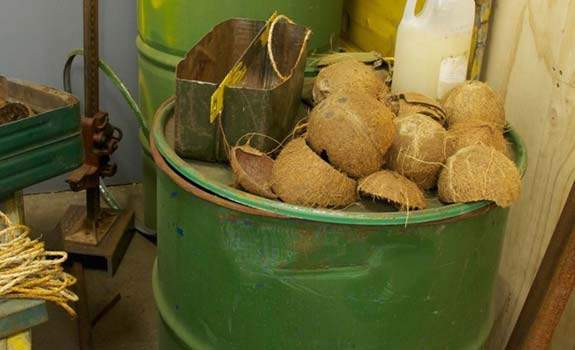Progress in Action
Nicholson Mangan's crazy in the coconuts exhibition is that rare kind of art that inspires further research and exploration.
Overview
Political art can often feel too blunt or on the nose. Nicholas Mangan's creation of an operational coconut-oil refinery accompanied by copper etching replicas of photographs and newspapers might seem obscure at first, but a cursory glance over Progress In Action's historical context reveals the direct nature of Mangan's exhibit. Therein lies the beauty of the work — propelled to ask what coconut oil and copper have to with anything, the viewer moved to do some investigating of their own will unravel a story of greed, murder and civil war just a stone's throw away from Australian shores.
Progress In Action centres around a fascinating moment in history: the establishment in 1964 of the Panguna mine in Bouganville, a small autonomous country within Papua New Guinea. The digging of the mine was an enormous economic investment by Australian mining company Rio Tinto, as the copper-rich island yielded enough profit to make up over 20% of the nation's total GDP. Interesting, then, that the local population saw only 0.5% of those profits.
By the late '80s Bouganville's local population, who had long been protesting the mine's devastating environmental impact as well as its extreme social implications (a state of Apartheid was imposed on the island, separating white workers from the native citizens) militarised into the Bouguanville Revolutionary Army (BRA) and began to wreak havoc upon the mine. In response, the PNG government sent in its own troops and in a diabolical move, completely blockaded the island, sealing the BRA in with the mine and shutting them off from medical supplies and food imports.
With all external resources denied them, the Bouganvillian population resourcefully improvised various tactics to survive, the most ingenius of which was to use coconuts as fuel. With no petroleum available, they instead refined coconut meat to power generators and engines, running their cars and power systems off the island's plentiful natural resource. They continued to fight back and the mine was eventually shut down in 1989. This is where outsider Mangan enters the scene. Through Progress In Action, Mangan has replicated the MacGyvered oil refinery system, producing enough coconut fuel to power a video artwork about the continuing environmental struggles in Bouganville.
Progress in Action may lack much in the way of striking spacial composition and breathtaking craft, but the exhibition's simply and effectively communicated, compelling back story makes it difficult to fault as a political arts experience. It's so rare to find visual art that inspires and encourages the viewer to further explore and research its subject, but Mangan provides an exception that shows us how art can be more than just a pretty picture.
Image credit Nicholas Mangan, Progress In Action





